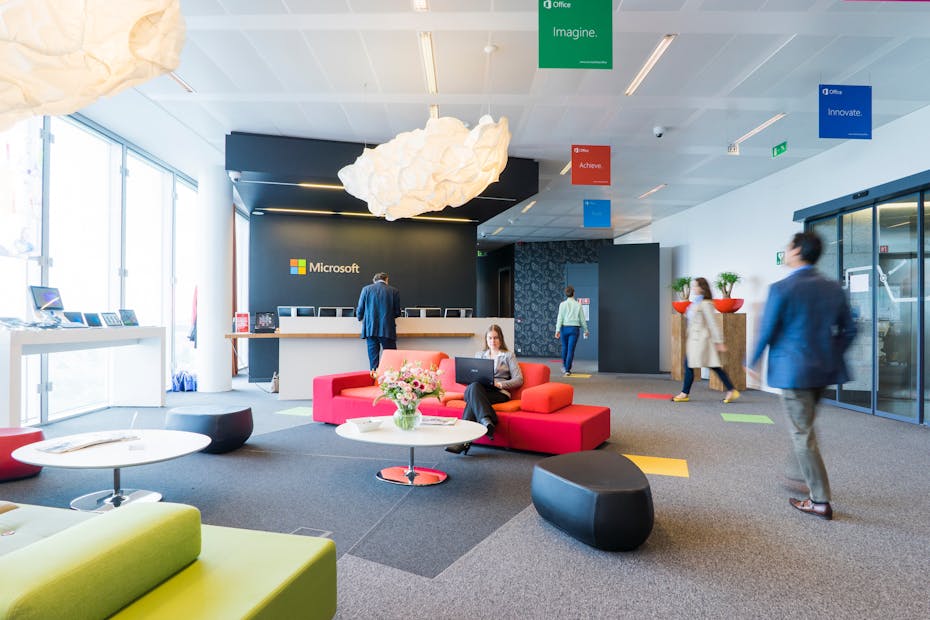The modern workplace is undergoing a significant transformation, with interior design playing a crucial role in shaping how employees interact, collaborate, and innovate. Futuristic workspaces prioritize flexibility, technology integration, and employee well-being, fostering environments that boost both productivity and creativity. By rethinking office layouts, incorporating cutting-edge materials, and embracing smart technology, companies are redefining what it means to work efficiently in the 21st century.
The Evolution of Workspaces
Traditional offices were once characterized by rigid structures, closed cubicles, and uniform layouts. However, with the rise of technology, remote work, and a greater understanding of workplace psychology, companies are shifting toward more dynamic and adaptable spaces.
From Cubicles to Open-Concept Offices
Older work environments were designed for efficiency, often at the expense of employee comfort. The shift to open-concept offices aimed to foster collaboration and transparency, but it also brought challenges such as noise distractions and a lack of privacy.
The Rise of Hybrid and Remote Work
The pandemic accelerated the adoption of remote and hybrid work models, requiring companies to rethink their office spaces. Modern workplaces now focus on creating an environment that attracts employees back to the office while supporting flexibility and virtual collaboration.
Key Elements of Futuristic Workspaces
Futuristic office designs are characterized by several core elements that enhance productivity and creativity.
Smart Technology Integration
Workspaces are becoming increasingly tech-driven, incorporating smart lighting, AI-powered assistants, and automated systems to streamline tasks and improve efficiency.
- IoT-Enabled Workspaces – Smart sensors adjust lighting and temperature based on occupancy and preferences.
- Virtual and Augmented Reality – VR and AR technologies are used for remote collaboration, training, and interactive presentations.
- AI and Machine Learning – Intelligent assistants help manage schedules, automate repetitive tasks, and improve workflow.

Flexible and Adaptive Layouts
Modern offices prioritize versatility, allowing spaces to be easily reconfigured for different tasks and work styles.
- Modular Furniture – Adjustable desks, movable walls, and reconfigurable seating support both collaboration and focused work.
- Hot Desking and Co-Working Spaces – Employees can choose where to work based on their needs, reducing unused office space.
- Multi-Use Meeting Rooms – Spaces designed for video conferencing, brainstorming sessions, or individual deep work.
Biophilic Design for Well-Being
Biophilic design integrates natural elements into workspaces, promoting mental well-being and reducing stress.
- Green Walls and Indoor Plants – Improve air quality and provide a calming atmosphere.
- Natural Lighting and Views – Enhances mood, reduces eye strain, and improves overall well-being.
- Water Features and Organic Materials – Create a sense of tranquility and connection to nature.
Wellness-Centric Design
Employee well-being is a central focus of futuristic workspaces, with designs that support both physical and mental health.
- Ergonomic Furniture – Adjustable chairs, sit-stand desks, and posture-supporting seating reduce strain.
- Quiet Zones and Meditation Spaces – Encourage mindfulness and provide relief from workplace stress.
- Fitness and Relaxation Areas – On-site gyms, nap pods, and wellness rooms help employees recharge.
How Interior Design Boosts Productivity
A well-designed workspace directly impacts employee efficiency and focus.
Reducing Distractions and Enhancing Focus
Acoustic panels, private work pods, and soundproof meeting rooms help minimize noise distractions in open offices.
Encouraging Collaboration and Innovation
Design elements such as brainstorming rooms, writable walls, and informal lounge spaces facilitate idea-sharing and teamwork.
Improving Employee Morale and Engagement
Aesthetic appeal, comfortable furniture, and personalized workstations contribute to higher job satisfaction and motivation.
How Interior Design Enhances Creativity
Futuristic office spaces are designed to inspire and stimulate creative thinking.
Incorporating Playful and Artistic Elements
Murals, interactive installations, and bold color schemes energize the workspace and encourage creativity.
Providing Inspiring Work Environments
Unique and unconventional spaces, such as rooftop work areas or theme-based meeting rooms, break monotony and spark innovation.
Offering Diverse Work Settings
Providing employees with different environments—quiet zones, social hubs, outdoor spaces—allows them to choose what best suits their creative process.

The Future of Workspaces: What’s Next?
As technology and workplace culture continue to evolve, future office designs will further prioritize adaptability, employee experience, and seamless integration between physical and digital work environments.
AI-Driven Personalization
Offices will use AI to customize lighting, temperature, and desk settings for individual employees, creating a highly personalized work environment.
Sustainable and Net-Zero Workspaces
Green architecture, recycled materials, and energy-efficient buildings will dominate future office designs.
Metaverse and Virtual Workspaces
As remote work expands, virtual offices in the metaverse will offer immersive and interactive work experiences, bridging the gap between physical and digital collaboration.
Conclusion
Futuristic workspaces are redefining how we work by integrating technology, flexibility, and well-being into office design. By embracing these innovations, companies can create environments that not only boost productivity but also inspire creativity, ensuring a more dynamic and fulfilling work experience for employees.
